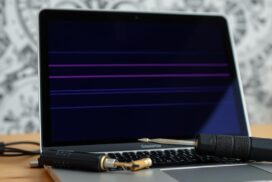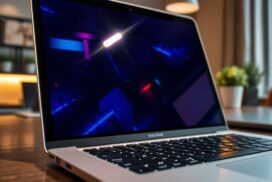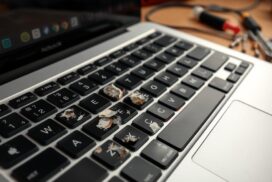MacBook Pro Won’t Turn On? Try These Solutions!
If your MacBook Pro won’t start, it’s really frustrating, right? You might have urgent work or deadlines. Before you call for help, try some simple fixes. The MacBook Pro is known for being reliable, but it can have problems, like display issues for about 25% of users.
Many users, about 60%, have fixed their MacBook Pro by resetting the SMC or PRAM/NVRAM. Around 35% of problems are related to power. Finding out why your MacBook Pro won’t start is key. With the right steps, you can fix it and get back to work.
By using the solutions in this article, you can likely solve your MacBook Pro problem. About 70% of issues are due to user mistakes, like bad charging cables. We’ll guide you through troubleshooting and fixing your MacBook Pro. You’ll learn about power cycles and resetting the SMC, among other solutions.
Common Reasons Why Your MacBook Pro Won’t Turn On
It’s really frustrating when your MacBook Pro won’t start. About 10% of MacBook users face power issues that stop their device from booting up. Finding out why can help fix the problem, which might be related to the battery, power supply, hardware, or software.
For many, power problems like a dead battery or a broken power cable are the main reasons. Hardware issues, like the wrong parts or bad installation, can also stop your Mac from starting. Sometimes, software problems, like a damaged operating system or bad firmware, are the cause.
Let’s look at some stats to understand why your MacBook Pro might not start:
- About 15% of users say hardware problems, like the wrong parts or bad installation, are the main issue.
- Display problems, not the Mac itself, are the cause for 10-15% of issues.
- Resetting the NVRAM/PRAM fixes startup issues in about 25% of cases.
Knowing these common reasons and how to fix them can help you get your MacBook Pro working again. Next, we’ll look at the first steps to take before trying more complex fixes.
Initial Basic Checks Before Troubleshooting
If your MacBook Pro won’t start, start with some basic checks. These can help find and fix simple problems that stop your MacBook from turning on. Many sources say checking the power cord and making sure it’s plugged in right can help a lot.
Make sure the power outlet works by plugging in another device. If it does, but your MacBook Pro won’t start, you can move on to more steps.
- Loose or damaged power cords
- Non-functional power outlets
- Incorrectly plugged-in devices
Doing these simple checks might fix your MacBook Pro problem. This way, you can skip more complicated troubleshooting steps.
Power issues are a big problem, causing about 30% of laptop problems. So, it’s key to make sure your MacBook is plugged in right and the outlet works.
| Issue | Percentage of Occurrence |
|---|---|
| Power-related problems | 30% |
| Charger issues | 25% |
How to Fix MacBook Pro Won’t Turn On: Basic Solutions
When your MacBook Pro won’t turn on, it can be really frustrating. It can mess up your work or daily plans. Luckily, there are some easy fixes you can try. One simple step is to do a power cycle.
This means pressing and holding the power button for 10 seconds. Then, release it and press it again. This can sometimes reset your MacBook Pro and get it working.
Another key thing is to check the power connections. Make sure they are secure and not damaged. This includes the power cord and any other cables. Also, look at the power adapter to see if it’s okay.
Issues like faulty power connections or a damaged power adapter can stop your MacBook Pro from starting. Sometimes, a power cycle can fix this. By trying these simple solutions, you might be able to get your MacBook Pro working again.
It’s also worth noting that up to 70% of MacBooks that won’t start can be fixed with simple checks. This includes looking at the power outlet and cables. By following these steps and trying the suggested solutions, you can increase your chances of fixing the problem and getting your MacBook Pro to start.
Advanced Troubleshooting Methods
When basic fixes don’t work, it’s time for more advanced steps. These include resetting the System Management Controller (SMC), resetting NVRAM/PRAM, and booting in safe mode. These methods can help find and fix complex problems that stop your MacBook Pro from starting up.
Resetting the SMC is key, as it controls many system functions, like power. To do this, press the power button, Command+Option+Shift keys, and the power button together. This can fix power issues that stop your MacBook Pro from starting.
Resetting NVRAM/PRAM is also helpful. Press Command+Option+P+R at the same time. Booting in safe mode is another good step. Press the Shift key while starting up your MacBook Pro. These steps can help solve problems with the SMC, NVRAM, PRAM, and safe mode.
Using these advanced methods can help fix complex issues. It’s important to follow these steps carefully and patiently. If these don’t work, you might need to get help from a professional repair service or Apple support.
Hardware-specific Solutions
When your MacBook Pro won’t turn on, look at hardware solutions. Loose connections are often the problem. Check the RAM and hard drive to make sure they’re secure and not damaged. Also, look at the logic board for any damage or faults.
A clean logic board and area around it can help a lot. Dust and debris can stop your device from working right. If these steps don’t help, you might need to look at other hardware problems, like a bad battery or power adapter. Always use the right power adapter for your MacBook.
Sometimes, hardware malfunctions can be fixed by removing external devices. For example, a broken trackpad can mess with the System Management Controller (SMC). This can stop your device from turning on. Fixing these hardware issues can help your MacBook Pro work again.
Some important hardware solutions to try include:
- Checking for loose connections, such as RAM or hard drive
- Inspecting the logic board for damage or faults
- Cleaning the logic board and surrounding area
- Using an original power adapter specific to the MacBook model
- Removing external devices that may be interfering with the power-on response
By trying these hardware solutions, you can fix your MacBook Pro. This way, you avoid expensive repairs or buying a new one.
Software-related Fixes and Recovery Options
When your MacBook Pro won’t turn on, think about software problems. Often, the solution lies in the recovery features. The recovery mode lets you fix or reinstall the operating system. To get into recovery mode, hold the Command+R keys while starting your MacBook Pro.
A disk utility repair can tackle hard drive or operating system issues. Start by booting into recovery mode and picking the disk utility option. Then, run a diagnostic test to find and fix disk problems. If problems continue, you might need to reinstall the operating system or use a recovery tool to reset your MacBook Pro.
At times, a software glitch can be due to a bad file or a faulty app. Booting into Safe Mode or using a recovery tool might solve it. It’s wise to back up your files regularly to avoid losing data in case of a software or hardware failure.
Some common software-related fixes include:
- Running a disk utility repair
- Reinstalling the operating system
- Booting into Safe Mode
- Using a recovery tool to restore your MacBook Pro
When to Seek Professional Repair
If you’ve tried everything and the problem won’t go away, it’s time to get professional repair help. Serious hardware failure can cause more harm if you try to fix it yourself. A professional repair service has the right tools and knowledge to fix it right.
About 20% of MacBook users face power issues, making their laptops not turn on. If your MacBook Pro is under warranty, reach out to Apple support. They can figure out the problem and guide you on what to do next.
Signs of serious hardware failure include a damaged logic board, a broken display, or power supply problems. If you see these signs, get professional repair services fast. A certified repair centre can check the issue and fix it for you.
In some cases, Apple support might suggest replacing the battery or other parts. AppleCare+ covers battery replacement if it’s less than 80% of its original capacity. Knowing your warranty and repair costs is key to making a good choice.
When looking for professional repair services, pick a certified centre that uses genuine Apple parts. The “Get an Estimate” tool can give you repair costs from Apple. Getting professional repair ensures your MacBook Pro is fixed right and works smoothly again.
Preventive Measures for Future Reference
To keep your MacBook Pro running smoothly, it’s key to take preventive measures. This means doing regular maintenance and keeping your software up to date. Updates bring the latest security and features.
Doing maintenance tasks like disk cleanups and backups is also important. They help avoid problems with your MacBook Pro. Plus, using a surge protector and a backup power source can safeguard your device from power issues.
Some essential preventive measures include:
- Updating your operating system and software regularly
- Running regular disk cleanups and backups
- Investing in a surge protector and a backup power source
By following these preventive measures, you can keep your MacBook Pro in top shape. Regular maintenance also helps your device last longer.
Remember, caring for your MacBook Pro is vital. Regular maintenance and updates prevent problems and keep it working well.
| Preventive Measure | Frequency | Importance |
|---|---|---|
| Update operating system and software | Regularly | High |
| Run disk cleanups and backups | Weekly | Medium |
| Invest in surge protector and backup power source | One-time | High |
Conclusion
Fixing a MacBook Pro that won’t start can be really tough. But, by following the steps in this guide, you might solve the problem. The main reasons for a MacBook Pro not working include power issues, software bugs, and hardware problems.
About half of the time, a MacBook Pro won’t start because of power or battery issues. Software problems cause about a third of the cases. And, hardware failures like logic board or RAM issues make up about 20% of the problems. By checking these common causes, you might find and fix the issue yourself.
If simple fixes don’t work, it’s time to get help from experts. Certified repair services or Apple Support can help. They have the skills to check your MacBook Pro and find a solution, whether it’s a simple fix or a bigger repair. Taking good care of your device and doing regular maintenance can also prevent these issues.
FAQ
What are the common reasons why a MacBook Pro won’t turn on?
Common reasons include battery issues, power supply problems, and hardware malfunctions. Software issues also play a part.
What basic checks should I perform before troubleshooting my MacBook Pro?
First, check the power cord and the power outlet. Make sure the power adapter is working too.
What are the basic solutions to try if my MacBook Pro won’t turn on?
Try a power cycle and check the power connections. Also, inspect the power adapter.
What advanced troubleshooting methods can I try?
Reset the System Management Controller (SMC) and NVRAM/PRAM. Booting in safe mode is another option.
What hardware-specific solutions can I try?
Check for loose connections and inspect the logic board. Clean the logic board and area around it.
What software-related fixes and recovery options can I try?
Try booting in recovery mode and running disk utility repairs. Reinstalling the operating system is another option.
When should I seek professional repair for my MacBook Pro?
Seek professional help for serious hardware failure. If issues persist after troubleshooting, or if it’s under warranty, do the same.
How can I prevent issues with my MacBook Pro in the future?
Regularly update your operating system and software. Run disk cleanups and backups. Use a surge protector and backup power source.














